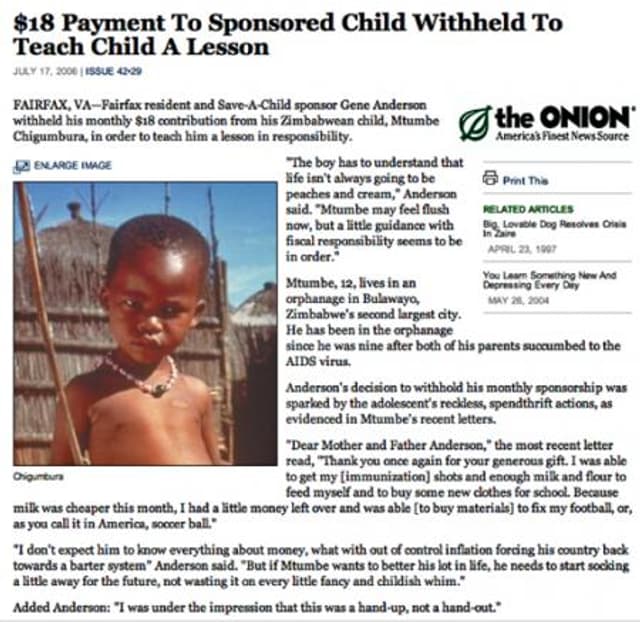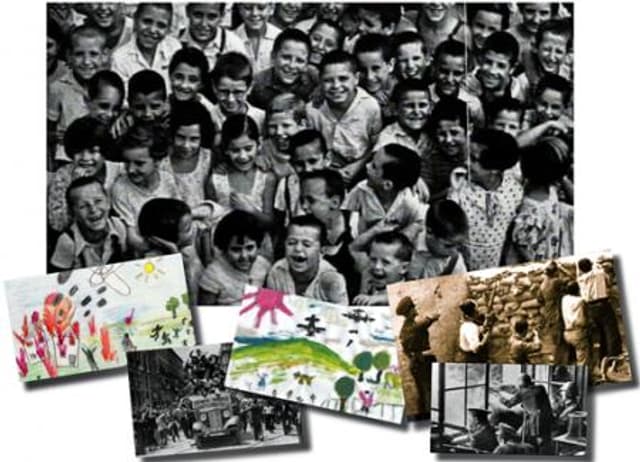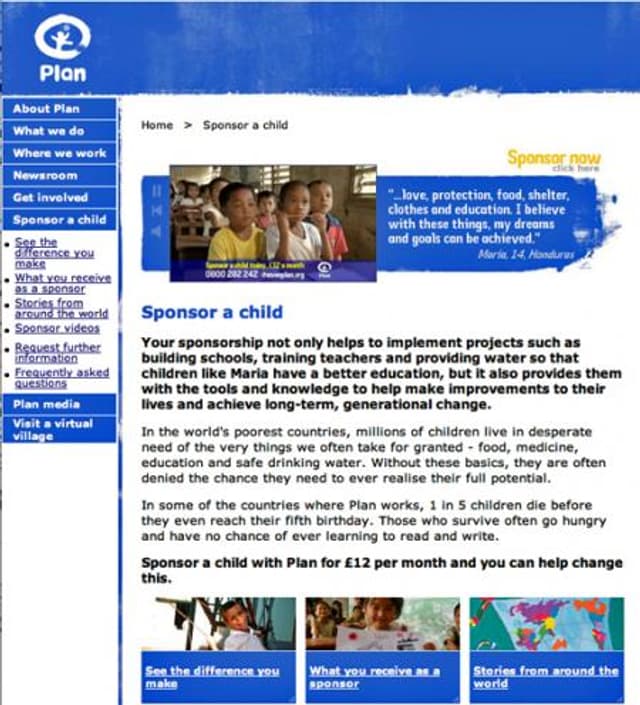THE PLAN: the launch of child sponsorship, Spain 1937
- Exhibited by
- SOFII
- Added
- March 03, 2009
- Medium of Communication
- Broadcast and television, direct mail, inserts, press advertising
- Target Audience
- Regular gift
- Type of Charity
- Children, youth and family, poverty / social justice
- Country of Origin
- Spain, UK
- Date of first appearance
- 1936
SOFII’s view
There is no more effective public fundraising proposition than child sponsorship, so its story is of high interest to any student of what works well in fundraising. This exhibit focuses on a documentary film made by Plan International, which shows how the idea emerged and grew as a response to the dangers faced by children in the Spanish civil war, more than 70 years ago. It shows that, like many great ideas, its origins are earlier than many might have supposed.
SOFII's view continues below with some observations on the reasons why, despite some concerns, child sponsorship continues to have such a powerful appeal for donors and fundraisers.
THE PLAN: the launch of child sponsorship, Spain 1937
Edited highlights from the film can be seen here, or you can view the unedited 15-minute below.
Creator / originator
Not sure, but Plan’s John Langdon-Davies is the earliest claimant that we know of, from 1936 or 1937.
Summary / objectives
The proposition is simple. You can’t help the faceless starving millions, but you can change the life of one child, whom you can know and learn about through a carefully managed long distance relationship. An old Chinese proverb sums it up quite nicely: it’s better to light a single candle than to curse the darkness.
Background
There are child sponsorship schemes of all types and variety operating in most developed and developing fundraising markets.
Special characteristics
Child sponsorship is a sustainable way of raising large sums for development work around the world. It is an ideal vehicle for introducing high income long-term monthly giving. Its appeal therefore is initially financial and that it is hugely successful at this can be seen from the number of organisations that depend upon it for their success in fundraising. It is clearly also a powerful way of involving people who might not otherwise connect with the cause. Advocates of child sponsorship also believe that it fosters a genuine two-way link that is beneficial for both parties. It is expensive to administer, but it’s easy to justify the cost, even the high initial acquisition cost, when that is considered against the long-term financial equation. The child sponsorship system has its detractors. Many people consider child sponsorship to be patronising and degrading to the families and children involved. Some worry that it is paternalistic and overly emotional, while others are concerned about singling individuals for favoured treatment. Responsible child sponsorship agencies claim that they take pains to avoid any possibility of this. Many fear high costs operationally. But the agencies that run child sponsorship schemes have ready answers for such concerns. No system is perfect, of course, but most who support child sponsorship believe that its advantages firmly outweigh its disadvantages. It is however just an engagement and fundraising mechanism, not a reason for running an organisation. It is possible to sponsor a girl child, an orphan child and even a Christian child. Care though needs to be taken by any organisation promoting child sponsorship that it does so honestly and without encouraging division. It's hard to deny that child sponsorship is the most effective individual fundraising proposition of all time. It is iconic, it easily captures the imagination of concerned individuals everywhere and it offers a high value regular giving proposition that, once the first year is past (for that’s when people will drop out, if they are going to), will usually survive a decade or more of careful relationship management. In fact, the beauty of child sponsorship is that the relationship will probably survive and even thrive without much effort from the charity. What’s more, having a relationship with a child sponsor will ease the request for further special gifts, particularly for ‘disaster’ gifts whenever an emergency occurs. And this special relationship may well in time lead to major gifts and a substantial bequest or legacy too. Because the relationship lasts usually for several years child sponsorship opens the door to development education, potentially on a huge scale. Provided that subsequent communication is carefully managed, child sponsorship introduces an unparalleled number of caring individuals to the complex issues that surround the fight to end poverty. As long as the charity openly explains the true nature of the link from the outset and providing that the programme work that it supports is always professionally, sensitively and carefully organised and supervised, child sponsorship is hard to fault as a fundraising mechanism. ‘Look, things might be really bad here in America. But kids aren’t being mown down by machine guns. They’re not starving.’
Influence / impact
The success of the child sponsorship appeal underpins many of the world’s largest and most successful international development NGOs. Many people who first started fighting poverty as a child sponsor have gone on to take a long-term interest in development issues.
Details
Testing the effectiveness of different child sponsorship messages or approaches is relatively easy, whether advertising on TV, in printed media, via inserts, or through direct mail. Any robust sponsorship programme will keep a careful record of all tests in its guard book.
Costs
Because of the high donor lifetime values the financial equation for organisations promoting child sponsorship is usually very benign, though acquisition costs have risen steeply in most established fundraising markets over the years. It isn’t unusual now to have to pay several hundred pounds, dollars, or euros to acquire a single sponsor. But this wasn’t always so. SOFII’s founder, Ken Burnett, recruited sponsors for the charity ActionAid in his first fundraising job back in the 1970s. He recalls the early days of advertising in the quality Sunday press in Britain, when ActionAid’s acquisition cost actually fell to an average of £1.25 per sponsor, at a time when the charity was recruiting tens of thousands of sponsors in a year. But then, Ken is older than most hills and those were the days when it was possible to buy a packet of Spangles with a shilling, still have enough change left over to go to the pictures of a Saturday afternoon and buy a penny’s worth of broken biscuits on the way home. Quite what it cost Plan to acquire a new sponsor in 1937 is open to conjecture. Most probably they paid little or nothing but relied on free publicity – a trick employed very successfully over many years by Pierre-Bernard Le Bas when he launched the French charity Aide et Action in 1982.
Results
Sponsorship consistently outperforms almost all other fundraising products, perhaps with the exceptions of sponsor a duck or a whale, or similar. Many other species have benefited from the success of sponsorship schemes, particularly dogs (see Dogs Trust), cats and dolphins.
Merits
It’s of historical importance for fundraisers, no doubt.
Other relevant information
Child sponsorship is also claimed to have developed independently in North America, as a response to the number of mixed race (bi-racial) orphans born after the Korean War in 1953, though we have no evidence to suggest that this was not influenced by schemes set up elsewhere. There is a range of child sponsorship opportunities available to donors in the UK, USA and other countries. Links to a few of their websites are attached here.
http://www.actionaid.org.uk/100044/child_sponsorship.html
http://www.plan-uk.org/becomeasponsor/?gclid=CIW105br5ZYCFQ9PtAodZiPUOA
http://www.worldvision.org.uk/server.php?show=nav.29&rw.cm=
http://projectmala.org/uk/default.htm?gclid=CIaYxrnr5ZYCFQRPt
http://www.everychild.org.uk/content/Child%20sponsorship
http://www.himalayanlearning.org/
Unedited film clip by Plan UK

 View original image
View original image
 View original image
View original image
Also in Categories
-
- The SOFII history project
- Broadcast


















